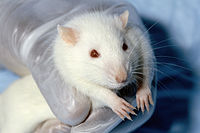
Photo from wikipedia
Although antiretroviral therapy (ART) has drastically changed the lives of people living with human immunodeficiency virus-1 (HIV-1), long-term treatment has been associated with a vast array of comorbidities. Therefore, a… Click to show full abstract
Although antiretroviral therapy (ART) has drastically changed the lives of people living with human immunodeficiency virus-1 (HIV-1), long-term treatment has been associated with a vast array of comorbidities. Therefore, a cure for HIV-1 remains the best option to globally eradicate HIV-1/acquired immunodeficiency syndrome (AIDS). However, development of strategies to achieve complete eradication of HIV-1 has been extremely challenging. Thus, the control of HIV-1 replication by the host immune system, namely functional cure, has long been studied as an alternative approach for HIV-1 cure. HIV-1 elite controllers (ECs) are rare individuals who naturally maintain undetectable HIV-1 replication levels in the absence of ART and whose immune repertoire might be a desirable blueprint for a functional cure. While the role(s) played by distinct human leukocyte antigen (HLA) expression and CD8+ T cell responses expressing cognate ligands in controlling HIV-1 has been widely characterized in ECs, the innate immune phenotype has been decidedly understudied. Comparably, in animal models such as HIV-1-infected humanized mice and simian Immunodeficiency Virus (SIV)-infected non-human primates (NHP), viremic control is known to be associated with specific major histocompatibility complex (MHC) alleles and CD8+ T cell activity, but the innate immune response remains incompletely characterized. Notably, recent work demonstrating the existence of trained innate immunity may provide new complementary approaches to achieve an HIV-1 cure. Herein, we review the known characteristics of innate immune responses in ECs and available animal models, identify gaps of knowledge regarding responses by adaptive or trained innate immune cells, and speculate on potential strategies to induce EC-like responses in HIV-1 non-controllers.
Journal Title: Frontiers in Immunology
Year Published: 2022
Link to full text (if available)
Share on Social Media: Sign Up to like & get
recommendations!